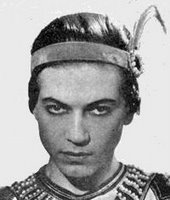 Serge Lifar born 2 April 1905 (d. 1986)
Serge Lifar born 2 April 1905 (d. 1986)Born in Kiev, Sergei Mikhailovich Serdkin was the last of Sergei Diaghilev's dancer-lovers. He used his looks, charisma and talent, fuelled by his fierce ambition to become one of the greatest dancers and choreographers of the 20th century.
 He enrolled in the Kiev Opera Ballet at age 15, and in 1923, Diaghilev asked Bronislava Nikinska, his ballet teacher, to provide her five best students for the Ballet Russes. Nijinska, who was not keen on Lifar, did not select him but one of the five dropped out and Lifar lept at his chance.
He enrolled in the Kiev Opera Ballet at age 15, and in 1923, Diaghilev asked Bronislava Nikinska, his ballet teacher, to provide her five best students for the Ballet Russes. Nijinska, who was not keen on Lifar, did not select him but one of the five dropped out and Lifar lept at his chance.Some say that Diaghilev was instantly drawn to the handsome 18 year-old dancer, others suggest that Lifar made sure Diaghilev noticed him, but his charm, persistance, whatever, paid off and he joined the list of Diaghilev star dancers/lovers in the footsteps of Nijinsky, Leonide Massine & Anton Dolin. This meant he was cast in leading roles and encouraged to choreograph, as Diaghilev had done before.
Given an inch of acclaim, Lifar kept taking so much that even the world-devouring Diaghilev became exasperated at his extreme ambition and self-promotion. By that point, however, Lifar was indispensable as a star and the only choice for plum roles such as Apollo in Balanchine's history-making Apollon musagète (1928) and the title role in Balanchine's The Prodigal Son (1929).
Lifar's own first ballet, Renard (1929, to a score by Igor Stravinsky), though energetic and athletic, proved to be no masterpiece. His later work, however, demonstrated that he had learned much from Diaghilev, Balanchine, and Stravinsky.
 He was at Diaghilev's bedside when he died in 1929, but the maestro's death left the Ballet Russes in chaos. However, Lifar was invited to star in a production at the Paris Opera Ballet, to be choreographed by George Balanchine, but his illness saw Lifar taking his place and he successfully went on to become ballet master and director of the Paris Opera Ballet until 1957 - although he was accused of collaborating with the German High Command during the Occupation of Paris and banished between 1944 and 1947.
He was at Diaghilev's bedside when he died in 1929, but the maestro's death left the Ballet Russes in chaos. However, Lifar was invited to star in a production at the Paris Opera Ballet, to be choreographed by George Balanchine, but his illness saw Lifar taking his place and he successfully went on to become ballet master and director of the Paris Opera Ballet until 1957 - although he was accused of collaborating with the German High Command during the Occupation of Paris and banished between 1944 and 1947.In Paris, he maintained the Diaghilev tradition, reviving not only Ballet Russes classics, but the fortunes of French ballet itself, developing the profile of male dancers and employing great choreographers - Balanchine, Massine and Frederick Ashton.
He remained a major figure in international ballet for the rest of his life and was, with Boris Kochno, Diaghilev's last love, the last of the line from the great Diaghilev. He died in Switzerland in 1986.